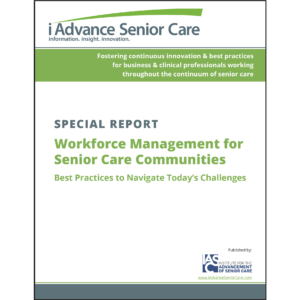How Senior Care Communities Approach Employee Retention in 2025
From the challenges brought on by the pandemic to the evolving landscape of the senior care workforce, employee turnover and retention remain critical issues for senior care communities. With high turnover rates still prevalent in the industry, retaining staff in 2025 requires a thoughtful and strategic approach.
Why Employee Retention is Key in 2025

Christopher Leinauer, executive director at Waltonwood at Ashburn
Employee retention is critical in senior care because it directly impacts the quality of care that residents receive. High turnover rates can cause disruptions in care routines, requiring residents to repeatedly build trust with new caregivers. Employee retention also impacts conflict management. Organizations that prioritize retention are able to create more stable environments with fewer interpersonal conflicts.
Christopher Leinauer, executive director at Waltonwood at Ashburn, explains that employee retention is critical to the community’s culture. “It’s a reflection of the environment we’ve intentionally created – one where our staff can feel like they belong,” he says. “We’ve seen firsthand how retention directly impacts resident satisfaction, and the contrast is noticeable when we’ve had to rely on agency staff, particularly during COVID, which disrupted that continuity of care,” explains Leinauer. The community’s focus on employee retention has paid off. The community had less than a 2% turnover rate in April 2025.
Employee Retention Strategies that Are Effective in 2025

Kimberly Best, RN, MA, founder of Best Conflict Solutions, LLC
Employee priorities have shifted since the pandemic, directly shaping the retention strategies that are most effective today. “Pre-pandemic, compensation was certainly important, but now I’m seeing greater emphasis on psychological safety and respect in the workplace,” says Kimberly Best, RN, MA, dispute resolution expert and founder of Best Conflict Solutions, LLC. “Staff members increasingly value environments where they can speak up about concerns without fear of retaliation. They’re looking for authentic inclusion in decision-making and recognition of their expertise regarding resident care.”
Best has found that the most effective retention strategies focus on conflict prevention and healthy resolution systems. These strategies include creating clear communication channels that staff members can use to address concerns, training supervisors in constructive feedback techniques, and establishing fair processes for addressing workplace disputes. “These approaches have become increasingly important since 2023, as workforce expectations continue to evolve post-pandemic,” says Best.
Waltonwood’s employee retention strategy hasn’t significantly changed over the years because it’s consistently proven to be successful. “We’ve built a culture where staff feel respected, empowered, and genuinely valued,” explains Leinauer. The community holds monthly all-staff meetings that celebrate the hourly team, and about 100 employees typically participate. Managers serve food, run raffles, and cover front desk duties so all staff can attend. The community publicly recognizes birthdays and anniversaries and creates a sense of inclusion and appreciation. Managers participate in quarterly off-site outings, like escape rooms and axe throwing.
“This people-first approach translates into real results,” says Leinauer. “Just today, a life enrichment manager celebrating her one-year anniversary told me she finally put up a photo of her kids in her office—something she’s never done at any other job. Despite a long commute, she loves the culture, feels supported, and is encouraged to be creative. Another nurse manager recently told me she’s staying until retirement because she’s never worked anywhere that feels more like family.”
Waltonwood’s approach begins with a strong onboarding process. The community pairs new team members with mentors and immerses them in the community’s core values. This approach focuses on showing real care, building relationships, and ensuring staff feel like they’re part of something meaningful. “We’ve found that some of the smaller, more generic efforts—like pizza parties—just don’t move the needle. People want genuine recognition and connection, not token gestures,” says Leinauer.
Best has also found that traditional retention approaches, such as hierarchal management styles and one-size-fits-all recognition programs, are less effective. “Today’s senior care workforce responds better to individualized appreciation and flexible problem-solving approaches,” she says.
Leinauer hasn’t noticed a trend of employees seeking additional or different benefits compared to pre-pandemic. “What we’ve found our employees consistently value most, besides the traditional 401K and healthcare offerings, is the atmosphere: a warm, welcoming environment where they feel included and respected,” he says. Waltonwood’s consistent staff programs and culture since 2019 have provided the stability needed to retain employees, even amid the challenges of the pandemic.
How to Identify What Employees Need and Want
Waltonwood uses a combination of written feedback, such as letters and suggestion boxes, as well as open forums where team members can speak in front of their peers to gather feedback. Leinauer also highlights the fact that he’s built strong personal relationships with many staff members, which makes them feel more comfortable bringing concerns to him directly. “That open-door culture is vital to employee retention and I always want people to know that they can give honest feedback without fear of it being held against them,” he says. “Building and maintaining trust is everything in building and maintaining a happy, motivated team.”
He emphasizes that the open-door policy is more than just symbolic – it’s actively practiced. Leinauer builds meaningful personal connections with his staff by knowing their families and individual stories.
How Senior Care Communities Can Improve Employee Retention
Best recommends that senior care communities looking to improve retention begin by assessing their conflict management culture. Consider how disagreements are typically handled, whether staff members feel heard, and whether feedback is welcomed or feared. “The answers to these questions often reveal opportunities for immediate improvement that can significantly impact retention,” she explains.
Leinauer encourages communities to start with an open-door policy that they actually live by, noting that the most valuable parts of Waltonwood’s staff meetings is the Q&A session where employees feel seen and heard amongst their peers. “Prioritize relationships and learn about your staff, value their lives outside of work, and treat them like more than just employees because at the end of the day, they’re spending more time here than at home, and if they’re not happy they won’t stay long,” he says. “This work is deeply personal and impactful, and the more you can foster positivity, laughter, and trust in your workplace, the better your retention will be.”

Paige Cerulli is a contributing writer to i Advance Senior Care.
Related Articles
Topics: Facility management , Featured Articles , Leadership , Operations , Staffing












